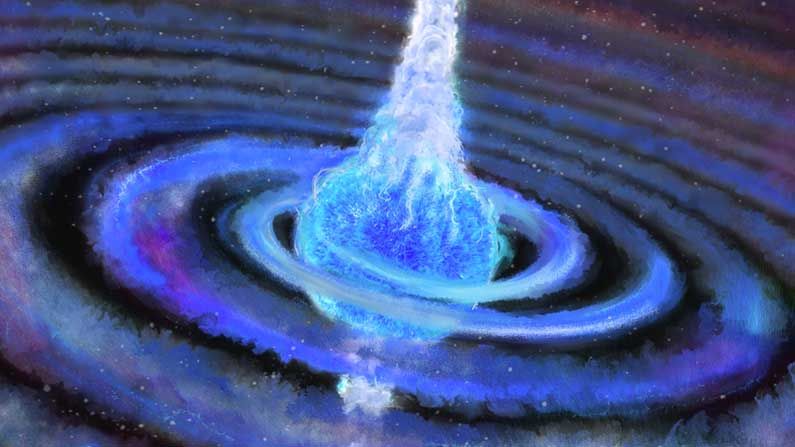
Astronomers have uncovered evidence of explosions triggered by dead stars ramming into live stars, possible proof of a new type of supernova, a new study finds.
Supernovas are gigantic explosions that can occur when stars die. These outbursts can briefly outshine all of the other suns in these stars' galaxies, making them visible from halfway across the cosmos.
For decades, researchers have known of two main supernova types. Large stars more than 10 times the sun's mass collapse in their centers when their cores burn all their fuel, causing the outer layers to explode and leaving behind a stellar remnant such as a neutron star or black hole. In contrast, stars less than eight times the sun's mass burn out over time, leaving behind a dense core known as a white dwarf, and these remnants can pull fuel onto themselves off companion stars until they detonate in a thermonuclear explosion.
Related: Supernova photos: Great images of star explosions
However, scientists have suggested other kinds of supernovas may exist. For example, most stars more than eight solar masses are born in close orbits to companion stars. The heavier members of these pairs may die first as supernovas, leaving behind a neutron star or black hole that can theoretically spiral toward its partner and collide, triggering a supernova.
Now astronomers may have discovered signs of such a merger-triggered core collapse supernova. They detailed their findings online today (Sept. 2) in the journal Science.
"This is the first of a new class of supernovae," study lead author Dillon Dong, an astrophysicist at the California Institute of Technology in Pasadena, told Space.com.
Using data from the Very Large Array Sky Survey (VLASS), a project that scans the night sky for radio outbursts, researchers detected an extremely luminous flare of radio waves, dubbed VT J121001+4959647, that happened in 2017. This outburst was not present in earlier radio surveys and is "tied for the most radio-luminous supernova ever detected," Dong said.
Through follow-up radio and optical analysis, the researchers found the radio flare came from a star surrounded by a thick, dense shell of gas. This envelope of matter was likely ejected from the star a few centuries before the radio signals were emitted.
"The progenitor star had undergone an episode of eruptive mass loss, ejecting more than the mass of the sun from its atmosphere," Dong said.
The astronomers suggest the radio outburst happened when the star exploded in a supernova, with debris from the explosion crashing into the surrounding gas shell, generating a blaze of radio waves.
The scientists then examined previous X-ray data. They found that in 2014, X-ray jets erupted from about the same place as VT J121001+4959647. They suggest these jets happened when a star went supernova, leaving behind a dead star that ripped gas off its companion, generating a dense gas shell. The luminous radio glow then occurred after the dead star rammed into its surviving partner.
"As the neutron star or black hole spirals in, it's expected to unbind a lot of the star's atmosphere and eject it out to large distances," Dong said. "And if it reaches the core, theory predicts that it can disrupt fusion, trigger a supernova and launch the jets that we observed."
"I had no idea that we would find such a system in VLASS," Dong said. "But that's kind of the beauty of it — we looked with open eyes at every possibly interesting source and let our experience, particularly of dead ends we've gone down in the past, and our intuition point us towards the ones to look further into."
The scientists now plan to further monitor VT J121001+4959647 to learn more about how pairs of massive stars spiral toward each other, something that is extremely difficult to model with computer simulations," Dong said. "Systems like this may be our best handle on the physics of what happens when two stars merge."
More discoveries may lie in wait, Dong added.
"One of the most exciting findings in astronomy of the past decade was that most massive stars are born in binary systems, triple systems, quadruple systems, and so on, and most of them are close enough to have strong interactions within the lifetime of the star," Dong said. "Where previously astronomers modeled these stars in isolation, we now realize that there is a rich set of phenomena to explore resulting from the interactions of these stars. A merger-triggered supernova, I think, is just scratching the surface of what's possible. With next-generation sky surveys and new developments in theoretical astrophysics, we may discover that stars behave in all sorts of unexpected ways."
Follow us on Twitter @Spacedotcom or Facebook.
"type" - Google News
September 03, 2021 at 01:07AM
https://ift.tt/38DdJq9
Star-smash supernova? New type of stellar explosion possibly seen - Space.com
"type" - Google News
https://ift.tt/2WhN8Zg
https://ift.tt/2YrjQdq
Bagikan Berita Ini














0 Response to "Star-smash supernova? New type of stellar explosion possibly seen - Space.com"
Post a Comment